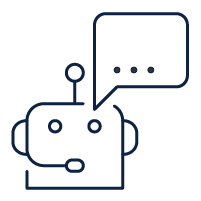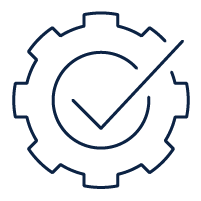Welcome to the UBC IT Automation Delivery Centre
Contact UsWe are a dedicated team committed to supporting efforts to improve efficiency and innovation at the University of British Columbia. Our mission is to help departments automate time-consuming and laborious business processes, freeing up valuable time and resources.
Leveraging state-of-the-art tools like for integrations and Robotic Process Automation, we offer a comprehensive suite of services from planning and assessment to design, development, implementation, and support. Join us on our journey towards operational excellence, as we harness the power of automation to transform the way we work at UBC. Explore our site to learn more about our services, meet our team, and discover how we’re making a difference through our success stories.
What is Robotic Process Automation (RPA)?
Robotic Process Automation (RPA) is the automation of routine, rule-based and repetitive tasks found in business processes through the use of automation software. UBC's implementation of RPA utilizes software that involves the use of software robots, or "bots", that can mimic and execute tasks that are typically performed by humans who are interacting with digital systems.
Software that can be used to automate routine, rule-based and repetitive tasks in business processes. It involves the use of software robots, or "bots", that can mimic and execute tasks that are typically performed by humans interacting with digital systems.

Automate tasks
Repetitive rule-based processes that are performed in volume. Can be initiated by a user or run automatically 24x7

Increase efficiency
Reduce staff time spent on low-value activity, and improve quality

Improve service
Enhance service by providing shorter response times, greater accuracy, 24x7
Automation can achieve
- Increased efficiency
- Cost savings
- Improved accuracy
- Compliance and auditability
- Enhanced Scalability
Other automation opportunities
UBC IT’s Automation Centre can help determine which type of automation might be best for each use case.
- Integrations
- Chatbots, virtual assistants
- Generative AI
- Appian business process automation software
- AI automation within existing systems (M365, Workday, Salesforce, ServiceNow)
What can be automated?
If the workflow can be documented, it can be automated.
Automate Repetitive Processes
Automate high volume repetitive tasks like data entry, document conversion, invoice processing, claims processing.
Integrate systems
RPA can move data between systems without the need for other integration tools (e.g. API's).
Automate user support
RPA can automate IT tasks like user account provisioning, account enquiries, password resets.
Extract data from documents
RPA can extract structured data from documents (scanned or PDF) like invoices, forms and emails.
Improve experience
RPA can automate service interactions, creating faster, consistent and error-free service experiences.
Automate reporting
RPA can generate reports by collecting data from multiple systems and in multiple formats.
Considerations when implementing RPA

Initial project cost
Implementing RPA requires an upfront investment in software and development. Establish clear goals whether cost savings, avoidance, or service improvement.

Generating ideas
Initially may be challenging to think about the work differently. After the first project and people see the ‘art of the possible’ more ideas are generated.

Cultural reluctance
Reluctance to automate if it means losing headcount or resources. Barriers to change can be reduced if benefits occur through improvements in service delivery, cost avoidance or attrition.
While RPA can generate long-term efficiency gains, to achieve expected outcomes, expectations and measurable goals should be established at the start.
About Us
At the Automation Solution Delivery Centre, we are committed to revolutionizing operational efficiency through the seamless integration of automation solutions. Aligned with UBC's Operation Excellence initiative, our goal is to optimize processes, reduce manual workloads, and elevate overall productivity.
By championing innovation and harnessing the power of RPA technologies, our team is dedicated to advancing UBC's commitment to collaboration, innovation, and system renewal.
Laleh Mosadegh - Director, Enterprise Automation
Laleh leads a dynamic team dedicated to the forefront of transformative technologies. In her portfolio, she oversees a spectrum of impactful initiatives, including Robotic Process Automation, Workday ERP Technical support, Salesforce platform, APIs-Integrations Enablement Centre, and IT PMO.
Laleh's unwavering commitment lies in driving strategic change and achieving business objectives that propels UBC to new heights, contributing to the overall success of the organization.
Majid Siddique Mohammed - Senior Manager
Majid leads the delivery team that collaborates across campus units, to drive automation projects that achieve not only substantial cost savings but also streamline operations, enhancing both staff and student experiences. In his prior role at UBC, Majid worked as a finance system integrations lead during UBC's Workday implementation.
Melissa Medearis - Automation Business Analyst
Melissa drives the automation requirements, collaborating with diverse stakeholders including developers, architects, subject matter experts, leadership etc. In her prior role at UBC, she was a Data Management Advisor with Population Data BC at Faculty of Medicine.
Dipendar Dhami - Automation Developer
With over 6 years of RPA development experience, Dipendar specializes in designing and implementing efficient automation solutions that drive operational excellence. His goal is to continuously innovate and optimize processes, contributing to the client success.
Sahil Passi - Programmer Analyst/ Senior Automation Developer
Sahil is a problem-solver at heart, turning complex business challenges into seamless automated solutions. He has delivered impactful automation projects across healthcare, insurance, retail, and financial services, leveraging UiPath, Microsoft Power Automate, and Automation Anywhere to optimize processes and drive efficiency. At UBC, he leads automation initiatives by designing intelligent workflows, mentoring developers, and pushing the boundaries of innovation. His mission? To make work smarter, faster, and more efficient—one automation at a time.
- Initiation: Clients are invited to kickstart the automation journey by submitting an Automation Intake Request on ServiceNow. This initiates the process, providing us with essential details about the desired automation scope.
- Assessment and Review: Our expert team thoroughly reviews the intake requests and schedules a Process Review Session with relevant stakeholders. This interactive session helps us understand the intricacies of the process, ensuring a comprehensive evaluation.
- Estimation: Post the Process Review, we provide clients with a detailed estimate of the cost and time required for the automation project. This transparency allows stakeholders to make informed decisions.
- Funding Approval and Formal Kickoff: Once the estimate is approved, the project officially kicks off following funding approval. This marks the beginning of a structured and collaborative journey.
- Implementation: The project undergoes a typical Software Development Life Cycle (SDLC), ensuring a systematic and effective development process. This includes design, development, testing, and deployment phases.
- Privacy Impact Assessment: As a safeguarding measure, a Privacy Impact Assessment is conducted for each process. This ensures that we adhere to the highest standards of data security and privacy protection, aligning with UBC's commitment to safeguarding its data and respecting privacy.
- Production Release: After successful development and rigorous testing, the project is released to production, bringing the automated solution to life and delivering tangible benefits to the University.
- Transition to Support: Our commitment extends beyond deployment. We ensure a seamless transition to support, providing ongoing assistance and maintenance to guarantee the continued success of the automated processes.
RPA Success Stories and Case Studies
Robotic process automation improved operational efficiency for the Payroll team, by automating payroll accounting adjustments. This process required changing worktags associated with employee salaries and benefits, which is a time consuming task involving multiple steps in Workday, and required 5 full time staff, with a 4 month backlog in requests.
The Workday process to make small dollar payments (those < $249) is frequently a cumbersome process and in many cases, the cost to UBC to process the transaction is higher than the amount being reimbursed.
UBC It worked with the Financial Operations team to develop pa bot that could automate the process. The automation is expected to go live in January 2024.
The bot will handle large volumes and is expected to save approximately $100,000 over the next 3 years, and importantly, improve the experience for UBC staff and through the streamlined process, result in more timely payments to external parties.
Enrolment Services had a highly manual process to download PDF transcripts from Classic SIS.
UBC IT worked with Enrolment Services to develop a bot to automate the process. Over 1000 hours of FTE time will be saved (approximately .5 FTE) until the new Workday system is implemented.
As an added benefit, service standards have been improved, reducing delivery times and reducing follow up email from students.
A need was highlighted to back-up 90 TB of Zoom video content in advance of enabling data retention policy within Zoom. The process to download and store the Zoom recording in another storage system would be highly manual process for faculty. UBC IT developed an automation solution that moved 90 TB of video recordings from Zoom to Amazon cloud storage. Using automation, the content was transferred within two weeks period while saving 1000+ hours of manual transfer time for UBC faculty.
To find out more about the service and pricing, please visit the Service Catalogue page.
